The Elite Five: My Top Credit Cards Delivering Maximum Value

What’s up, Stocksavvy family? Here at Stocksavvydad.com, we’re diving into all things finance, including credit cards and rewards. As a credit card rewards enthusiast for the past eight years, I’m excited to share my personal top five consumer credit cards. Think of it as my starting five lineup.
Now, before we dive in, let’s establish the golden rule of credit card use: Always pay off the balance in full each month. Getting into debt chasing credit card sign-up bonuses and points? That’s a rookie mistake. Spend only what you can comfortably afford and what you were planning to spend anyway. Clear? Fantastic! Also if you’re interested in improving your credit score check out my post about how to achieve an 800 credit score here.
The best way to earn a ton of points or miles, is through sign up bonuses (sub) bonuses, which is why I’ve accumulated quite a few credit cards. The five listed below are my go-to choices and make up my current starting five. While many blogs offer in-depth analyses of the best cards and points systems (shoutout to frequentmiler.com), it can be overwhelming for newcomers. My aim is to offer a straightforward perspective and hopefully inspire responsible card usage.
Quick Note: Since I spend a significant amount of time outside the U.S., credit cards with no foreign transaction fees are essential for me. All cards below, except one, waive foreign transaction fees. For U.S. residents, there are excellent cards with foreign transaction fees worth considering. Also, keep in mind that all these cards have an annual fee, but when used wisely, you’ll easily offset it and come out ahead.
Point Guard: Capital One Venture (Setup Man/Woman)
My favorite quality: Double rewards on all purchases
Current Sign-up Bonus (SUB): 75,000 Miles
Website Link: https://www.capitalone.com/credit-cards/venture/
Annual Fee: $95
If you’ve been in the game for a while, you’ve probably found yourself at the checkout line, wondering if you’re using the best card for the situation. Frankly, the guessing game can get tiresome and overwhelming. What I love about this card is it eliminates the guessing game by offering 2x miles on all purchases. Just swipe, earn your double miles, and go. I use this card for almost all purchases that aren’t food/grocery or travel-related, including at Costco in Canada, where only MasterCard is accepted (unlike in the U.S., where it’s Visa). Additionally, this card offers extra perks, which you can check out at the link above. There’s a chance I may replace this card with its big sister, the Venture X, this year as I re-balance my card portfolio.
Shooting Guard: American Express Cobalt Card (Canadian Specialist)

Amex Cobalt Card
My Favorite Quality: Earns 5x points on dining and Canadian grocery stores
Current SUB: 15,000 points, distributed monthly
Annual Fee: $155.98 CAD (paid monthly at $12.99 per month)
Apologies to my U.S. friends and family, but this one’s for my Canadian crew. One perk of being a U.S. citizen who also calls Canada home is having access to both American and Canadian credit card options. Let’s face it, the U.S. credit card ecosystem is far superior, offering better perks and much juicier sign-up bonuses.
However, even in the land of maple syrup and hockey, the Amex Cobalt Card shines as my go-to. It racks up 5x points on dining out and groceries, plus 2x on public transit. These 5x categories beat out the U.S. Amex Gold, which earns 4x in the same areas, and all for a lower annual fee (though to be fair, the Amex Gold’s bonus applies internationally).
What makes it even sweeter is that with a bit of maneuvering, I can combine the Amex points I earn on this card with my U.S. points, unlocking travel partners exclusive to U.S. Amex cardholders. But let’s address the elephant in the room: Amex isn’t as widely accepted in Canada, especially in grocery stores.
My only other gripe? The SUB is underwhelming. The monthly installment payment of the annual fee softens the blow, but breaking up the sign-up bonus into monthly increments feels lackluster. To earn the full 15,000 bonus points for the year, you need to spend $750 CAD per month. It used to be a 30,000 bonus, but now you must spend $9,000 CAD over the year for just 15,000 bonus points. That’s quite weak, especially compared to the hefty SUBs Amex offers for their U.S. cards. Nonetheless, I still love this card for its earning potential.
While it may not be entirely fair to compare U.S. credit cards to Canadian ones, especially since most folks won’t have access to both ecosystems, for dual citizens like myself, the Amex Cobalt Card is a solid choice if it aligns with your lifestyle. Just don’t chase the SUB.
Small Forward: Citi Premier Card: Mr./Ms. Triple Double
My Favorite Quality: Earns 3x on Gas & 3x on groceries (international)
Current SUB: 60,000 points
Annual Fee: $95
When my Amex card gets the cold shoulder at grocery stores, the Citi Premier Card steps up to the plate. It’s a versatile all-around player, scoring 3x points at grocery stores, dining spots, gas stations, and travel purchases (excluding transit).
With a $95 annual fee and a robust lineup of travel partners, including Choice Hotels, this card is a standout in the market. One of its standout features is earning 3x points on international grocery purchases. This addresses one of my main gripes with the Amex Gold (U.S. version), where the 4x bonus on groceries only applies to U.S. stores.
For me, the Citi Premier Card is an excellent card to have in your wallet for its versatility and strong earning potential, all for a modest annual fee.
Before we wrap this up, a quick shoutout to the Chase Sapphire Preferred. It’s similar to the Citi Premier Card and often considered the best overall travel card on the market. It was my first true travel card, and you can learn more about it here. If you’re new to the travel credit card game, you may want to start with the Chase Sapphire Preferred.
Power Forward: Jetblue Plus Card, Airline Specialist

My Favorite Quality: Free 1st checked bag for up to 3 people
Current SUB: 60,000 bonus points
Annual Fee: $99
Unlike the other cards in my starting lineup, the JetBlue Plus Card isn’t part of a transferable rewards program. This means the points earned are mainly usable for JetBlue flights. Typically, I’m not big on branded airline and hotel cards for this reason.
However, if you’re a frequent JetBlue flyer or even just fly with them occasionally, this card is a must-own. Firstly, it offers the perk of a free first checked bag for up to 3 passengers, saving you significant money on baggage fees. Considering the 1st checked bag costs $35 on flights within North America, and even more on transatlantic flights, the $99 annual fee pays for itself on just one round-trip if you’re traveling with companions.
I fly the Vancouver-JFK route round trip about four times a year, often with my family in tow. This perk alone makes the annual fee worthwhile for me given the amount of luggage we generally carry.
Additionally, I use this card for JetBlue purchases to earn 6x points on all JetBlue flights, surpassing the earning rate of other premium cards on airline purchases. The card also offers other benefits, such as receiving 5,000 bonus points on your account anniversary and getting 10% of your points back on reward travel.
JetBlue points are quite valuable, especially for domestic travel, making this card a solid choice if you fly JetBlue frequently, particularly for flights within North America.
Center: Amex Platinum: The Big Boy
My Favorite Quality: Airport Lounge Access
Current SUB: Up to 150,000 points
Annual Fee: $695
Website Link: https://www.americanexpress.com/us/credit-cards/card/platinum/
Last but certainly not least, the American Express Platinum card. This card is the “Victor Wembanyama” of my lineup because of its massive annual fee, almost hitting $700.
I contemplated adding this card to my lineup for a long time, considering the hefty annual fee. However, when the sign-up bonus hit 120,000 points, it became an easy decision for me. At worst, I could pay the annual fee for the first year, collect the sign-up bonus, and then downgrade or cancel the card outright.
Now, many people refer to this card as a giant coupon book because of all the random perks and credits it provides, which you can view in the AMEX link above. Ultimately, you’ll have to decide if those credits are valuable to you.
For me, despite the annual fee, this card remains in my starting lineup still because of the extensive travel perks it offers, which I value greatly:
- Centurion Lounge Access
- Delta Sky Club access (when flying Delta, though changes are coming in 2025)
- Priority Pass Membership (providing lounge access, which some other travel cards also offer)
- $200 airline incidental fee credit
- 5x points on flights booked directly with airlines
- Fine Hotels and Resorts (FHR) benefits, including a $200 FHR credit each year
- Annual Clear Credit
- Hilton & Marriott gold status
If you’re in a city or frequently travel to cities with Centurion lounges or Delta Sky Clubs, the lounge access alone can offset the annual fee, despite the sometimes crowded conditions feeling like Rockefeller center during the holidays. I’ve also enjoyed the food options at the JFK and Las Vegas Centurion lounges, with the JFK lounge even featuring a cool “secret” speakeasy downstairs.

Additional Value
Additionally, I’ve found great value in the Fine Hotels and Resorts program and the perks it offers, especially when combined with the $200 annual credit. The guaranteed late checkout has been particularly useful, acting as an extended stay. Just be sure to compare hotel rates on Amex’s travel portal to ensure they align with the property’s website.
For now, this card works well for me, but I’ll reassess its value once the annual fee hits. I do not recommend this card if you don’t travel as some of the non-travel perks, while nice, probably aren’t worth the annual fee.
There you have it, the credit cards that round out my starting five. Remember, what works for me may not work for you, so consider your own lifestyle and financial situation when choosing your cards. As savvy investors, I encourage you to research companies like Visa, Mastercard, and American Express to determine if they’re worth investing in. Personally, I hold positions in both Visa and AMEX. Drop a comment below and share which cards round out your starting five or are simply in your wallet. Let’s keep the conversation going!